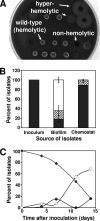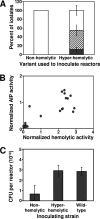Generation of virulence factor variants in Staphylococcus aureus biofilms
- PMID: 17675387
- PMCID: PMC2168666
- DOI: 10.1128/JB.00789-07
Generation of virulence factor variants in Staphylococcus aureus biofilms
Abstract
Several serious diseases are caused by biofilm-associated Staphylococcus aureus. Colonial variants occur in biofilms of other bacterial species, and S. aureus variants are frequently isolated from biofilm-associated infections. Thus, we studied the generation of variants with altered expression of virulence factors in S. aureus biofilms. We observed that the number of variants found in biofilms, as measured by hemolytic activity, varied for different strains. Further study of hemolytic activity and signaling by the accessory gene regulator (Agr) quorum-sensing system in one S. aureus strain revealed three primary biofilm subpopulations: nonhemolytic (Agr deficient), hemolytic (Agr positive), and hyperhemolytic (also Agr positive). The nonhemolytic variant became the numerically dominant subpopulation in the biofilm. The nonhemolytic variant phenotype was stable and heritable, indicating a genetic perturbation, whereas the hyperhemolytic phenotype was unstable, suggesting a phase variation. Transcription profiling revealed that expression of the agr locus and many extracellular virulence factors was repressed in the nonhemolytic variant. Expression of the agr-activating gene, sarU, was also repressed in the nonhemolytic variant, suggesting one potential regulatory pathway responsible for the Agr-deficient phenotype. We suggest that the development of these variants in biofilms may have important clinical implications.
Figures




Similar articles
-
Molecular characterization of regulatory genes associated with biofilm variation in a Staphylococcus aureus strain.J Microbiol Biotechnol. 2008 Jan;18(1):28-34. J Microbiol Biotechnol. 2008. PMID: 18239412
-
Impact of the agr quorum-sensing system on adherence to polystyrene in Staphylococcus aureus.J Infect Dis. 2000 Dec;182(6):1688-93. doi: 10.1086/317606. Epub 2000 Oct 13. J Infect Dis. 2000. PMID: 11069241
-
agr-Genotyping and transcriptional analysis of biofilm-producing Staphylococcus aureus.FEMS Immunol Med Microbiol. 2007 Oct;51(1):220-7. doi: 10.1111/j.1574-695X.2007.00298.x. FEMS Immunol Med Microbiol. 2007. PMID: 17854479
-
Quorum sensing-mediated regulation of staphylococcal virulence and antibiotic resistance.Future Microbiol. 2014;9(5):669-81. doi: 10.2217/fmb.14.31. Future Microbiol. 2014. PMID: 24957093 Review.
-
Staphylococcus quorum sensing in biofilm formation and infection.Int J Med Microbiol. 2006 Apr;296(2-3):133-9. doi: 10.1016/j.ijmm.2006.01.042. Epub 2006 Feb 17. Int J Med Microbiol. 2006. PMID: 16487744 Review.
Cited by
-
Endogenous oxidative stress produces diversity and adaptability in biofilm communities.Proc Natl Acad Sci U S A. 2008 Aug 26;105(34):12503-8. doi: 10.1073/pnas.0801499105. Epub 2008 Aug 21. Proc Natl Acad Sci U S A. 2008. PMID: 18719125 Free PMC article.
-
Cell differentiation defines acute and chronic infection cell types in Staphylococcus aureus.Elife. 2017 Sep 12;6:e28023. doi: 10.7554/eLife.28023. Elife. 2017. PMID: 28893374 Free PMC article.
-
Factors contributing to the biofilm-deficient phenotype of Staphylococcus aureus sarA mutants.PLoS One. 2008;3(10):e3361. doi: 10.1371/journal.pone.0003361. Epub 2008 Oct 10. PLoS One. 2008. PMID: 18846215 Free PMC article.
-
Evolution of Ecological Diversity in Biofilms of Pseudomonas aeruginosa by Altered Cyclic Diguanylate Signaling.J Bacteriol. 2016 Sep 9;198(19):2608-18. doi: 10.1128/JB.00048-16. Print 2016 Oct 1. J Bacteriol. 2016. PMID: 27021563 Free PMC article.
-
Comparison of Staphylococcus aureus strains for ability to cause infective endocarditis and lethal sepsis in rabbits.Front Cell Infect Microbiol. 2012 Feb 21;2:18. doi: 10.3389/fcimb.2012.00018. eCollection 2012. Front Cell Infect Microbiol. 2012. PMID: 22919610 Free PMC article.
References
-
- Akiyama, H., T. Hamada, W. K. Huh, O. Yamasaki, T. Oono, W. Fujimoto, and K. Iwatsuki. 2003. Confocal laser scanning microscopic observation of glycocalyx production by Staphylococcus aureus in skin lesions of bullous impetigo, atopic dermatitis, and pemphigus foliaceus. Br. J. Dermatol. 148:526-532. - PubMed
-
- Bergdoll, M. S., B. A. Crass, R. F. Reiser, R. N. Robbins, and J. P. Davis. 1981. A new staphylococcal enterotoxin, enterotoxin F, associated with toxic-shock-syndrome Staphylococcus aureus isolates. Lancet 1:1017-1021. - PubMed
-
- Bernheimer, A. W. 1988. Assay of hemolytic toxins. Methods Enzymol. 165:213-217. - PubMed
Publication types
MeSH terms
Substances
Associated data
- Actions
LinkOut - more resources
Full Text Sources
Molecular Biology Databases

